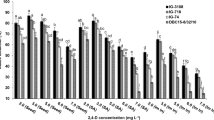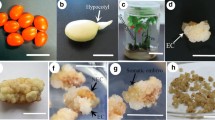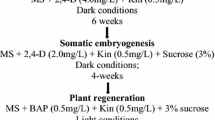Abstract
A new, simple and efficient method was developed for multiple shoot regeneration of cumin from imbibed embryo cultures. This method yielded a large number of shoots within short period of time (30–50 days) without any subculturing. The effects of different media, different embryo explants and various combinations of plant growth regulators (PGRs) on callus formation and shoot regeneration in cumin were investigated. Simultaneous callus formation and shoot regeneration was obtained. The best response for multiple shoot regeneration was observed on B5 medium containing 1.0 mg l−1 BAP, 0.2 mg l−1 NAA and 0.4 mg l−1 IAA, with an average of 140 shoots per explant.
Similar content being viewed by others
References
Agrawal S (1996) Volatile oil constituents and wilt resistance in respondcumin (Cuminum cyminum L.). Curr. Sci. 71: 177–178
Arpaia S, Chiriatti K & Giovanni G (1998) Predicting the adaptation of Colorado potato beetle (Coleoptra: Chrysomelidae) to the transgenic eggplants expressing CryIII toxin: the role of gene dominance, migration, and fitness costs. J. Econ. Entomol. 91: 21–29
Baran T, Chandra S & Gopal M (1983) In vitro culture of Cuminum cyminum regeneration of flowering shoots from calli of hypocotyl and leaf explants. Plant Cell Tiss. Org. Cult. 2: 11–14
Champawat RS & Pathak VN (1990) Field screening of cumin germplasm against Fusarium oxysporium f.sp. cumini. J. Arecanut. Spices 13: 142
Chi CM, Zhang C, Staba EJ, Cooke TJ & Hu WS (1996) Spectral approach to population dynamics of carrot somatic. J. Ferlm. Bioeng. 81: 445–452
Chriqui D, David C & Adam S (1988) Effect of differentiated or dedifferentiated state of tobacco pith tissue on its behavior after inoculation with Agrobacterium rhizogenes. Plant Cell Rep. 7: 111–114
Gamborg OL, Miller RA & Ojima K (1968) Nutrient requirements of suspension cultures of soybean root cells. Exp. Cell Res. 50: 151–158
Gould J & Magallance-Cedeno M (1998) Adaptation of cotton shoot apex culture to Agrobacterium-mediated transformation. Plant Mol. Biol. Rep. 16: 1–10
Hamza S & Chupeau Y (1993) Re-evaluation of conditions for plant regeneration and Agrobacterium-mediated transformation of tomato (Lycopersicom esculentum). J. Exp. Bot. 44: 1837–1845
Hemphill JK, Maier CGA & Chapman KD (1998) Rapid in-vitro plant regeneration of cotton (Gossypium hirsutum L.). Plant Cell Rep. 17: 273–278
Hidetoshi H, Matsuno T, Yamamoto NM, Matsubayashi Y, Toshi-hiro K & Kamad AH (2000) A secreted peptide growth factor, phytosulfokin, acting a simulatory Factor of carrot somatic embryo formation. Plant Cell Physiol. 41: 27–32
Hussein MA & Batra A (1998) In vitro embryogenesis of cumin hypocotyl segments. Adv. Plant Sci. 11: 125–127
Jain SC, Purohit M & Jain R (1992) Pharmacological evaluation of Cuminum cyminium. Fitoterapia 63: 291–294
Kim YW, Youn Y, Noh ER & Kim JC (1999) Somatic embryogensis and plant regeneration from immature zygotic embryos of Japan-ese larch (Larix Leptolepis). Plant Cell Tiss. Org. Cult. 55: 95–101
Lawrence BM (1995) Progress in essential oils. Perfumer and Flavorist 20: 47–54
Murashige T & Skoog F (1962) A revised medium for rapid growth of and bioassays with tobacco tissue cultures. Physiol Plant. 15: 473–497
Nhut DT, Le BV & Van KTT (2000) Somatic embryogenesis and direct shoot regeneration of rice (Oriza sativa L.) using thin cell layer culture of apical meristematic tissue. J. Plant Physiol. 157: 559–565
Omar EA, Nofal MA, Lashin SM & Haggage WME (1997) Effect of some growth regulators on growth parameters and oil content of cumin wilt disease incidence under two types of soil. Egyptian J. Hort. 24: 29–41
Sangwan RS, Bourgeois Y, Brown S, Vasseur G & Sangwan NB (1992) Characterization of competent cells and early events of Agrobacterium-mediated genetic transformation in Arabidopsis thaliana. Planta 188: 439–456
Satyavathi VV, Prasad V, Gita LB & Lakshmi SG (2002) High efficiency transformation protocol for three Indian cotton va-rieties via Agrobacterium tumefaciens. Plant Sci. 162: 215–223
Skirvin RM, McPheeters KD & Norten M (1994) Source and frequency of somaclonal variation. Hort. Science 29: 1232–1237
Stuart MK, Barak AV & Burkholder WE (1994) Immunological identification of Trogoderma granarium everts. J. Stored Prod. Res. 30: 9–16
Tawfik AA (1998) Plant regeneration in callus culture of cumin (Cuminium cyminium L.). Acta Hort. 457: 389–393
Tawfik AA & Noga G (2001) Adventitious shoot proliferation from hypocotyl and internodal stem explants of cumin. Plant Cell Tiss. Org. Cul. 66: 141–147
Torbet KA, Rines HW & Somers DA (1998) Transformation of oat using mature embryo-derived tissue cultures. Plant Cell Tiss. Org. Cult. 38: 226–231
USDA, Animal and Plant Health Inspection Service (1998) Kaphra Beetle (Trogoderma granarium), Pest Risk Assessment (p. 28)
Vits H, Chi CM, Staba EJ, Cooke TJ & Hu WS (1994) Characterizing Patterns in somatic embryo cultures: its morphology and development. AIChE J. 40: 1728–1740
Wu G, Shortt BJ, Lawrence EB, Levin EB & Fitzsimmons KC (1995) Disease resistance conferred by expression of a gene encoding H O-generating glucose oxidase in transgenic potato 2 2 plants. Plant Cell 7: 1357–1368
Yan B, Reddy MS, Collins GB & Dinkins RD (2000) Agrobacterium tumefaciens-mediated transformation of soybean using immature zygotic cotyledon explants. Plant Cell Tiss. Org. Cult. 19: 1090–1097
Zapata C, Park SH, El-Zik KM & Smith RH (1999) Transformation of a Texas cotton cultivar by using Agrobacterium and the shoot apex. Theor. Appl. Genet. 98: 252–256
Zcan M & Erkmen O (2001) Antimicrobial activity of the essential oils of Turkish plant spices. Eur. Food Res. Tech. 212: 658–663
Zhang Z, Coyne DP, Vidaver AK & Mitra A (1998) Expression of human lactoferrin cDNA confers resistance to Ralstonia solanacearum in transgenic tobacco plants. Phytopathology 88: 730–734
Author information
Authors and Affiliations
Corresponding author
Rights and permissions
About this article
Cite this article
Ebrahimie, E., Habashi, A., Ghareyazie, B. et al. A rapid and efficient method for regeneration of plantlets from embryo explants of cumin (Cuminum cyminum). Plant Cell, Tissue and Organ Culture 75, 19–25 (2003). https://doi.org/10.1023/A:1024676507010
Issue Date:
DOI: https://doi.org/10.1023/A:1024676507010




